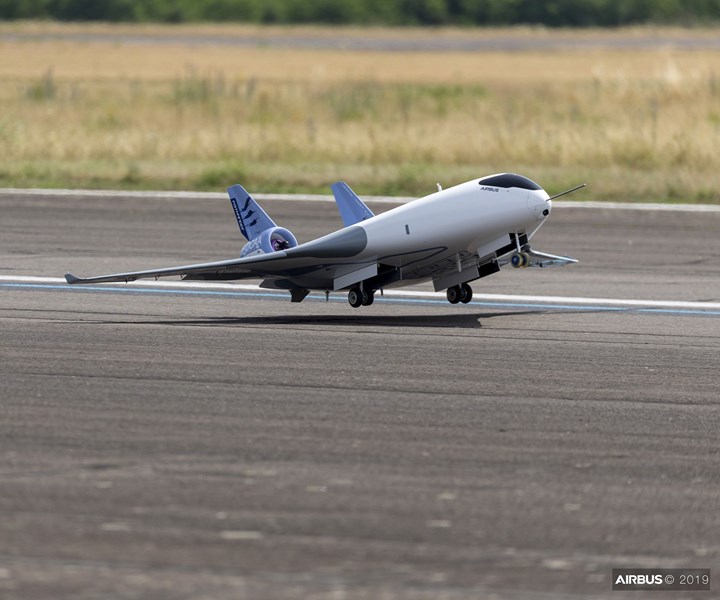Airbus reveals blended wing aircraft demonstrator
MAVERIC is a scale-model demonstrator for a new aircraft model that Airbus says could reduce fuel consumption by up to 20% compared to current single-aisle aircraft.

The MAVERIC demonstrator during takeoff. Source | Airbus
On Feb. 11, Airbus revealed a scale model demonstrator of its blended wing body aircraft design. Called MAVERIC (Model Aircraft for Validation and Experimentation of Robust Innovative Controls), the 2-meters-long by 3.2-meters-wide demonstrator features what Airbus says is a disruptive aircraft design with the potential to reduce fuel consumption by up to 20% compared to current single-aisle aircraft. The blended wing body configuration also opens up new possibilities for propulsion systems type and integration, and the cabin is designed for a versatile new passenger experience.

Source | Airbus
Launched in 2017, MAVERIC’s first flight was in June 2019. Since then, Airbus reports that the the flight-test campaign has been ongoing and will continue until the end of the second quarter of 2020.
“Airbus is leveraging emerging technologies to pioneer the future of flight. By testing disruptive aircraft configurations, Airbus is able to evaluate their potential as viable future products,” says Jean-Brice Dumont, EVP Engineering Airbus. “Although there is no specific time line for entry-into-service, this technological demonstrator could be instrumental in bringing about change in commercial aircraft architectures for an environmentally sustainable future for the aviation industry.”
Airbus says it is collaborating closely with an extended innovation ecosystem to accelerate traditional research and development cycles, a system, the company says, enables it to quickly achieve proof of concepts, driving forward maturity and increasing value.
Through AirbusUpNext, a research program, Airbus is currently working several additional demonstrator projects in parallel with MAVERIC: E-FAN X, a hybrid-electric propulsion aircraft; fello’fly, a v-shaped “formation” flight aircraft; and ATTOL (Autonomous Taxi Take-Off & Landing).
Related Content
-
Al Seer Marine, Abu Dhabi Maritime unveil world’s largest 3D-printed boat
Holding the new Guinness World Record at 11.98 meters, the 3D-printed composite water taxi used a CEAD Flexbot to print two hulls in less than 12 days.
-
Sinonus launches energy-storing carbon fiber
Swedish deep-tech startup Sinonus is launching an energy-storing composite material to produce efficient structural batteries, IoT devices, drones, computers, larger vehicles and airplanes.
-
McLaren develops aerospace-inspired ART method for volume composite super car engineering
Automated rapid tape (ART) technique, already deployed at the MCTC and to be used for future McLaren models, is capable of producing lighter, stiffer and stronger carbon fiber structures with less waste.
.jpg;width=70;height=70;mode=crop)
.jpg;maxWidth=150;quality=70)




